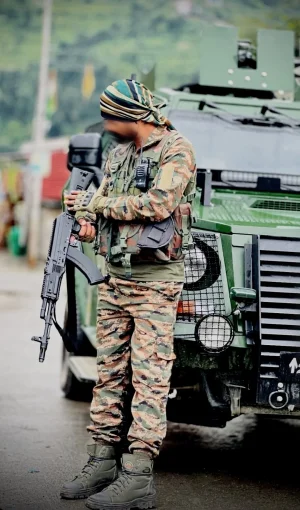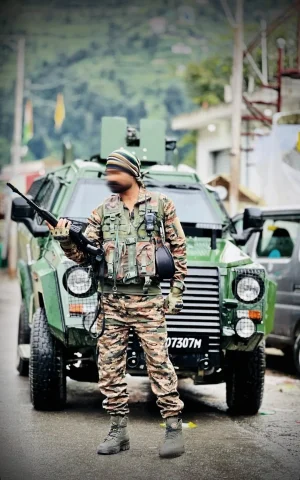Army has put in fresh order for 73,000 SIG 716 G2 patrol assault or battlefield rifles, chambered for 7.62x51 mm rounds from US firm SIG Sauer, attracting criticism for continued imports.
theprint.in
New Delhi: A formidable military power that just commissioned its second locally built nuclear powered ballistic missile submarine, India is struggling to equip its military personnel with even the most basic of defence items—the humble rifle.
Such is the state that even if all the modernisation programmes being pursued by the Army for over a decade and half come to fruition, its soldiers will be using at least three different types of rifles and carbines—all of different calibre.
The Indian Army’s fresh order for 73,000 SIG 716 G2 patrol assault or battlefield rifles, chambered for 7.62×51 mm rounds, from the US firm SIG Sauer has opened up a Pandora’s box, with several including indigenous arms manufacturer criticising it for continued imports and failure to hand hold the industry and promote them.
This comes even as domestic arms manufacturers have now started exporting snipers and assault rifles.
In a rare public outcry, Vivek Krishnan, CEO of Bengaluru-based small arms manufacturer SSS Defence, went public saying he wished “the government had not acquired more of these”.
He was referring to the SIG Sauer order, which is a follow-on of an earlier order made in 2019 under a fast tracked process through which the Army had bought 72,000 of these American rifles.
Krishnan said that a private solicitation and insistence on Indian design and content would have easily thrown up a contender, or many in fact. Testing the same against the in service system would have been rather easy, he added.
In 2020, ThePrint had reported that Indian small arms manufacturers were unhappy with the Army’s plan to re-order SIG Sauer rifles.
While there were no Indian products to be considered in 2018, multiple private companies had entered the small arms industry by 2020 and set up factories and plants either on their own, or through tie-ups with foreign firms.
Sources in the defence establishment explained that while companies claim that they have an indigenous product, it is not so. They added that companies are not able to deliver the quantity that is required since their rate of production capability is less.
The sources explained that in trials being done for other small arms, the companies have sought repeated extensions to submit rifles for consideration.
As the controversy brews, ThePrint takes a look at various programmes being run by the Army for small arms, and the twists and turns with them.
India’s quest for rifles
Way back in 2007, the Indian Army’s Infantry Directorate decided to move away from the 5.56X45 mm INSAS (Indian Small Arms System) rifle based on feedback from the ground troops and experiences from the 1999 Kargil War.
The global and the Indian arms companies have largely been frustrated with the Indian Army’s small arms programmes under which it keeps changing requirements, including the calibre (the diameter of the bullet or the barrel).
As mentioned earlier, the Army has failed to standardise on a single calibre for its rifles that has resulted in at least three different calibres (7.62×51 mm, 7.62×39 mm, and 5.56X45 mm) and multiple weapons.
Globally, militaries have largely stuck to one or at most two calibre as a standard. For example, the US military, which has seen the most number of conflicts since World War 2, has changed its rifle calibre and standard-issue rifle just twice since then.
The standard issue shoulder weapon to the American military is the M16A4, which is a modern version of the rifle that was introduced in the 1960s.
As for India, the Army did its own study and eventually came out with a tender in 2011. This tender confused small arms manufacturers across the world because the Army wanted a dual-calibre rifle chambered for two types of ammunition—7.62×39 mm and 5.56×45 mm.
This tender was eventually withdrawn in 2015, but this meant 8 years of planning went down the drain.
Another attempt was made in 2015, to buy modified INSAS 1C rifles. However, this was scrapped in August 2016 when the Army decided to go for a battle rifle chambered for the heavier 7.62×51 mm round.
In the meanwhile, India and Russia initiated talks at government-level to jointly manufacture the AK 103 rifle with 7.62×39 mm calibre. This rifle is the modernised version of the iconic Russian AK 47 rifle developed by General Mikhail Kalashnikov in 1947.
This deal was being pursued when the Ordnance Factory Board was already manufacturing cheaper AK-47 clones—the Trichy Assault Rifle (TAR), and the Ghatak.
Then in 2018 under the then defence minister Nirmala Sitharaman, a decision was taken to jointly manufacture the AK 203, a small upgrade of the AK 103. It is only this year that the India-Russia joint venture has delivered the first initial lot of AK 203 with bare minimum indigenous content to the Indian Army.
In 2018, the Army decided to pursue its original plan to go in for the battle rifle with the heavier 7.62×51 mm round. Incidentally, the INSAS was introduced to replace the 5.1 kg Ishapore 7.62×51 mm rifle which was used by soldiers in the Siachen battle and against the Liberation Tigers of Tamil Eelam (LTTE) in Sri Lanka.
When the Army started the process to acquire a 7.62×51 mm rifle starting in 2018, it decided to pursue the deal under fast tracked procurement (FTP) process. It capped the number of this rifle at 1.4 lakh to equip its frontline soldiers, while the rest were to get the AK 203s.
Accordingly, an empowered committee was formed by the Army which went to multiple countries to check out weapons. Since this was an FTP, no trials were done.
Several rifles were examined by the committee, which eventually chose the SIG 716, according to the sources.
One of the main reasons for the selection of the American rifle was the price, they said. It is understood that the American company had a large number of these rifles in their inventory and had offered a cheaper price than what other companies were asking for.
Accordingly, a deal was inked in 2019 for 72,400 SIG 716 rifles—66,400 for the Army, 4,000 for the Air Force and 2,000 for the Navy. The Army decided that it would go for a follow-on order for an additional 73,000 rifles. But, the follow-on order got delayed with the government’s push against imports.
In 2022, ThePrint reported that contrary to certain media reports, the follow-on order for the SIG Sauer rifles was on track.
The defence sources explained that the follow-on order for the American rifles was already decided and that it just took some extra time.
The original plan was to induct 1.4 lakh SIG 716 rifles and the rest of the Army’s requirement was to met by the AK 203s being produced in India.
“So, it is wrong to say that the Indian Army is going in for imports. All other programmes like that for light machine guns, snipers, and carbines are for Indian companies,” one of the defence sources said.
The sources explained that way back in 2018, there was no Indian company making such rifles in the country. Though an indigenous weapon system is available now, they said that the Army cannot function with 72,000 of one system and 73,000 of another.
The carbine saga
The Army’s quest for close quarter battle (CQB) carbines—a project initiated in 2008 to replace the outdated and ageing British Sterling submachine gun—is still being pursued with field trials taking place at the moment.
As the Research and Development Organisation (DRDO) and the OFB failed to meet the Army’s requirements, a global tender for procurement of 44,618 CQB carbines was issued in 2011.
While Israel Weapon Industries (IWI), Italian Beretta, and American firms Colt and SIG Sauer participated in the tender, only IWI qualified as the other contenders could not meet the qualitative requirements with regard to the night vision mounting system.
However, the deal did not go through because of a single vendor case, which, according to the government’s procurement manual, is not allowed.
In 2017, a global Request for Information (RFI)—a process initiated to gather information on what is available in the market—was issued for the purchase of 2 lakh carbines, while a separate process was rolled out to procure 93,895 under FTP.
UAE’s Caracal had emerged as the lowest bidder in the FTP process, but the contract for its CAR 816 ran into rough weather over various issues, including costs and complaints from other bidders.
In 2020, ThePrint reported that the government had decided to scrap the project altogether.
The Army has now initiated a Make in India programme under which 4.25 lakh carbines are to be procured for its personnel. The companies in contention include PLR of the Adani Group, Jindal, Kalyani Group and two others, including ICON, which has tied up with Caracal.
SSS Defence could not make it into the list because it could not meet the minimum financial markings that were needed, it is learnt.
The sources indicated that PLR, which now manufactures the Galil Ace in India, and Caracal are the strong contenders.
Sniper rifles
The other programme that the Indian Army is pursuing is for the procurement of 4,500 sniper rifles. The companies in contention are SSS Defence, PLR and Kalyani Group. However, the trials are yet to start.
LMGs
The Army is also pursuing a programme to procure 41,000 light machine guns (LMGs), under the ‘Make in India’ initiative. These would be the 7.62X51 mm belt-fed LMGs, to replace the 5.56x45mm INSAS LMG.
Adani Group’s PLR systems, which is a joint venture with the IWI, is the frontrunner with their Negev NG 7. The IWI had already won a fast-tracked procurement contract from the Army for about 16,000 Negev NG 7s and delivered them.
Incidentally, the Army contract was directly with IWI and not with the Indian joint venture, which now manufactures various Israeli weapons at its Gwalior plant.





